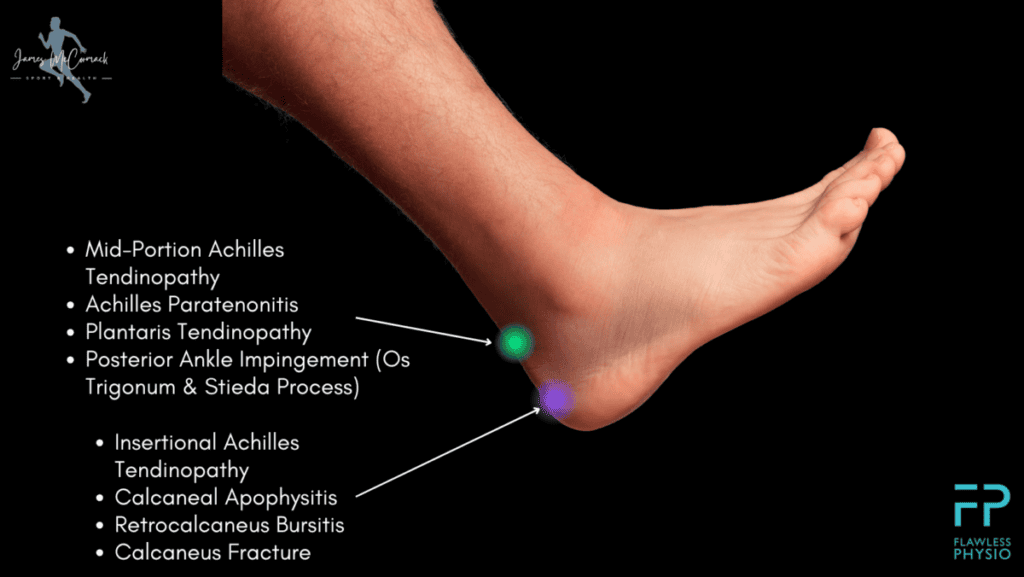Posterior Ankle Pain
- Best Asics Shoes for Flat Feet - October 25, 2024
- Best Running Shoes for Flat Feet - October 22, 2024
- Posterior Tibial Tendonitis - October 21, 2024
Posterior ankle pain is often mistakenly diagnosed as Achilles Tendonitis, but several conditions can present similarly to Achilles Tendonitis. Numerous conditions cause pain in the back of the ankle. We will explore all of these conditions in this article.

Tendon Pain
Common things are common, and therefore, we will begin with Achilles Tendonitis. We subdivide Achilles Tendon pain based on the location and type of pain present. The most prevalent is Mid-Portion Achilles Tendonitis, located approximately 2-6cm above the heel bone.
Insertional Achilles Tendinopathy (Tendonitis) occurs where the heel attaches to the heel bone (calcaneus), often called enthesopathy. When this pain is present in adolescents, it is referred to as Sever’s Disease or Calcaneal Apophysitis.
Whilst the location of the pain is different, the pattern of pain for mid-portion and insertional Achilles tendinopathy is the same. We expect stiffness in the morning when walking or after sitting for periods.
A warming effect is common, where the pain improves with activity but worsens afterwards. We explain these conditions in detail in separate articles, including footwear and support options.
A sudden overload of the Achilles Tendon can cause swelling between the tendon and the synovial sheath, resulting in Achilles Tendosynovitis. Patients often present with acute tenderness along the length of the tendon, with audible crepitus and swelling.
Another lesser-known cause of tendon pain in the posterior ankle is Plantaris Tendonitis. This long, thin tendon can cause pain along the medial border of the Achilles Tendon.
Joint Pain
Posterior Ankle impingement is a broad term for pain in the ankle joint’s back during terminal plantarflexion. Conditions include a Steida process, an extra bony growth on the Talus bone or an Os Trigonum, where an extra bone or cartilage is formed. When going onto your toes, these bony structures can pinch tendons like the Posterior Tibial Tendon and Flexor Hallucis Tendon.
Bone Pain
A Lover’s Fracture or Calcaneal fracture can result from trauma such as a fall from a height or a car crash. It can also result from a progressive heel overload, and we often see this in endurance athletes due to the high volume of impact activity combined with under-fueling. We screen these patients for RED-S.
These patients are often placed in a CAM Walker boot but may require a surgical opinion before commencing rehabilitation.
Bursitis
The retrocalcaneal bursa and subcutaneous burse sit on the back of the heel bone between the calcaneus bone and the Achilles Tendon. If one or both of these bursa become irritated through compression or overuse, it can result in swelling and acute tenderness to the touch.
We commonly see these conditions in conjunction with Achilles Tendinopathy.
Nerve Pain
The sural nerve is superficial and can easily irritate by muscular or fascial entrapment, ankle sprains, and overstretched muscles. When the sural nerve becomes irritated, it is called Sural Neuritis, which can replicate Achilles Tendinopathy Pain.
One of the key differences between Sural Nerve Pain and Achilles Tendinopathy is that pain is often constant, worsening with exercise rather than improving.
Insights from Flawless Physio
This article was crafted by James McCormack, a specialist in lower limb health and an expert in treating a wide range of foot-related conditions. If you’re experiencing any of the issues discussed here, seeking advice from a qualified healthcare provider is essential. James is available for online consultations and in-person visits at his London clinic.
At Flawless Physio, we provide expert care for various foot conditions, including Plantar Fasciitis. You can schedule an appointment with one of our foot specialists at our Soho clinic.
Feel Good, Move Better, Live Healthier
